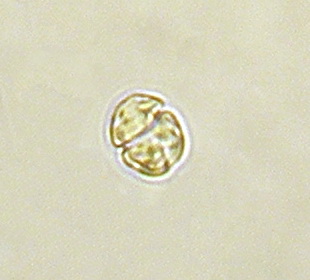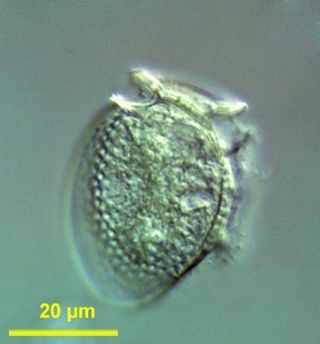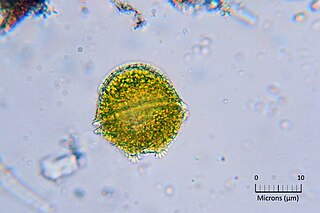
The Noctilucales are an order of marine dinoflagellates. They differ from most others in that the mature cell is diploid and its nucleus does not show a dinokaryotic organization. They show gametic meiosis.

Gymnodinium is a genus of dinoflagellates, a type of marine and freshwater plankton. It is one of the few naked dinoflagellates, or species lacking armor known as cellulosic plates. Since 2000, the species which had been considered to be part of Gymnodinium have been divided into several genera, based on the nature of the apical groove and partial LSU rDNA sequence data. Amphidinium was redefined later. Gymnodinium belong to red dinoflagellates that, in concentration, can cause red tides. The red tides produced by some Gymnodinium, such as Gymnodinium catenatum, are toxic and pose risks to marine and human life, including paralytic shellfish poisoning.

Cylindroleberididae is a family of ostracods that shows remarkable morphological diversity. The defining feature is the possession of gills: 7–8 leaf-like pairs at the posterior of the body. Other features common to all species in the family include a "baleen-comb" on both the maxilla and the fifth limb, a sword-shaped coxal endite on the mandible, and the triaenid bristles on the basal endites of the mandible.

Charles Atwood Kofoid was an American zoologist known for his collection and classification of many new species of marine protozoans which established marine biology on a systematic basis.
The World Register of Marine Species (WoRMS) is a taxonomic database that aims to provide an authoritative and comprehensive list of names of marine organisms.

Peridinium is a genus of motile, marine and freshwater dinoflagellates. Their morphology is considered typical of the armoured dinoflagellates, and their form is commonly used in diagrams of a dinoflagellate's structure. Peridinium can range from 30 to 70 μm in diameter, and has very thick thecal plates.
Plagiopyla is a genus of ciliates. It includes nine species:

Dinophyceae is a class of dinoflagellates.
Histioneis is a genus of dinoflagellates. According to the World Register of Marine Species, it contains 86 species.

Dinophysis is a genus of dinoflagellates common in tropical, temperate, coastal and oceanic waters. It was first described in 1839 by Christian Gottfried Ehrenberg.

Gigantocypris, sometimes known as giant ostracod or giant seed shrimp, is a genus of ostracod crustaceans in family Cypridinidae, and among the most well-known members of the class Ostracoda. Its members are extremely large for ostracods, measuring up to 3.2 cm (1.3 in) across, have a globular shape, are typically semi-transparent orange or reddish, and have a large pair of mirror-like eyes that are used to locate their small animal prey. They are found worldwide in dark, deep and cold oceans.

Cypridinidae is a family of ostracods. About half of all known species are bioluminescent. Some use the light only for defence, others also for courtship displays. The linages with sexually dimorphic bioluminescent displays have more species other linages, which indicates that bioluminescent courtship could increase the diversification rates.

Tripos is a genus of marine dinoflagellates in the family Ceratiaceae. It was formerly part of Ceratium, then separated out as Neoceratium, a name subsequently determined to be invalid.
Centrodinium is genus of dinoflagellates in the order Gonyaulacales.

Ostreopsidaceae is a family of free-living dinoflagellates found in marine environments.
Irene Agnes McCulloch was a marine biologist and USC biological sciences professor. McCulloch started at the University of Southern California in 1924 where the marine biology research department lacked funding and resources. To better the research being done, McCulloch convinced George Allan Hancock to fund the G. Allan Hancock Foundation for Marine Research, which was then renamed the Hancock Institute for Marine Studies. McCulloch was given her own foundation in 1969 at USC to continue marine biology research. McCulloch studied microbes within the Pacific Ocean with her main focus being foraminifera.

Gymnodiniaceae is a family of dinoflagellates belonging to the order Gymnodiniales.

Gyrodinium is a genus of dinoflagellates belonging to the order Gymnodiniales within class Dinophyceae.
Michael "Buddy" Kofoid is an American professional dirt track and stock car racing driver. He competes full-time in the USAC National Midget Series and POWRi Lucas Oil National Midget Series, driving for Keith Kunz Motorsports. He is the 2021 and 2022 USAC National Midget Series champion. He also competed part-time in the NASCAR Camping World Truck Series, driving the No. 51 Toyota Tundra for Kyle Busch Motorsports, and part-time in the ARCA Menards Series, driving the No. 15 Toyota Camry for Venturini Motorsports. He also has competed with the NOS Energy Drink World of Outlaws Sprint car Series. He collected his first Win at Husets Speedway on June 23, 2022.
Warnowia is a genus of athecate dinoflagellates, characterized by having a very sophisticated photoreceptor organelle called the ocelloid. This genus is dispersed worldwide but is scarce and difficult to find and nearly impossible to culture. As a result, the history and taxonomy of this genus are confusing at best, and many basic characteristics like its life cycle are still unknown. Still, Warnowia has drawn scientific interest as a unicellular organism with a fascinatingly complex photoreceptor system.












